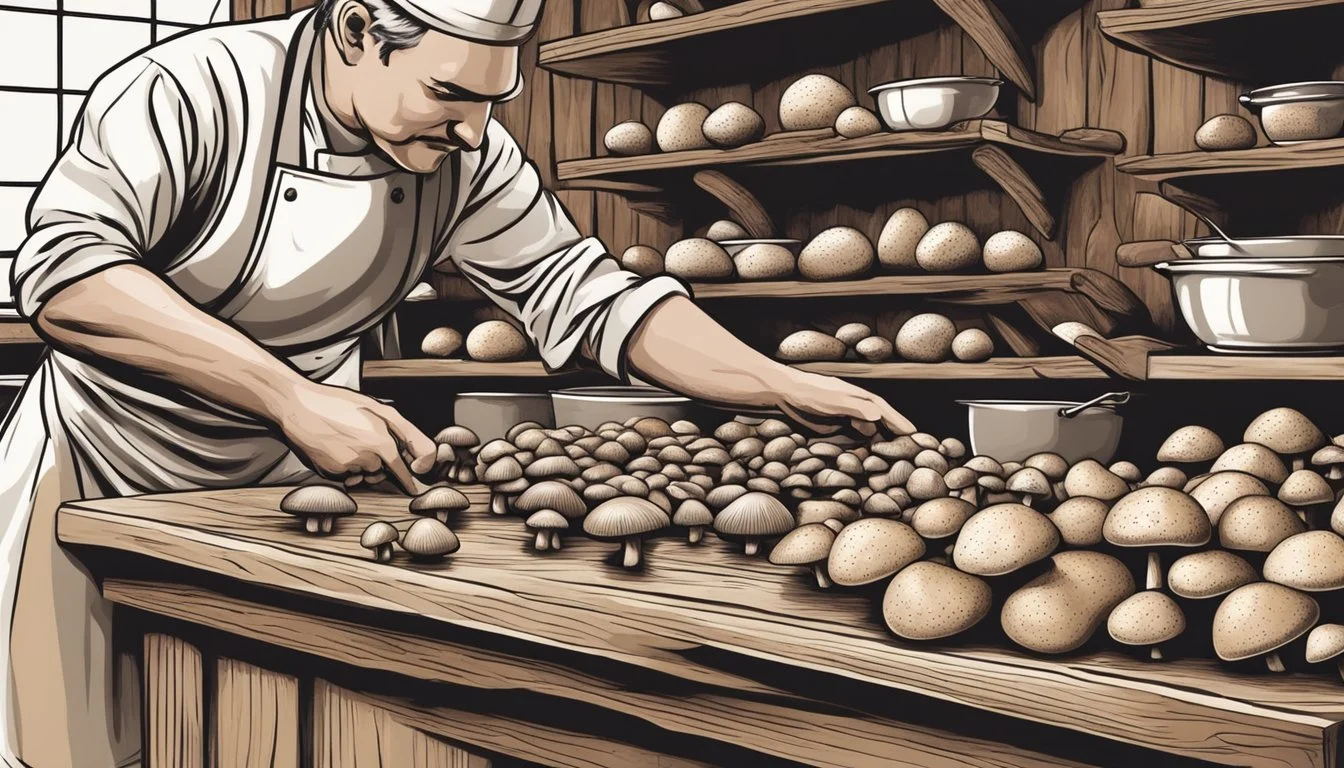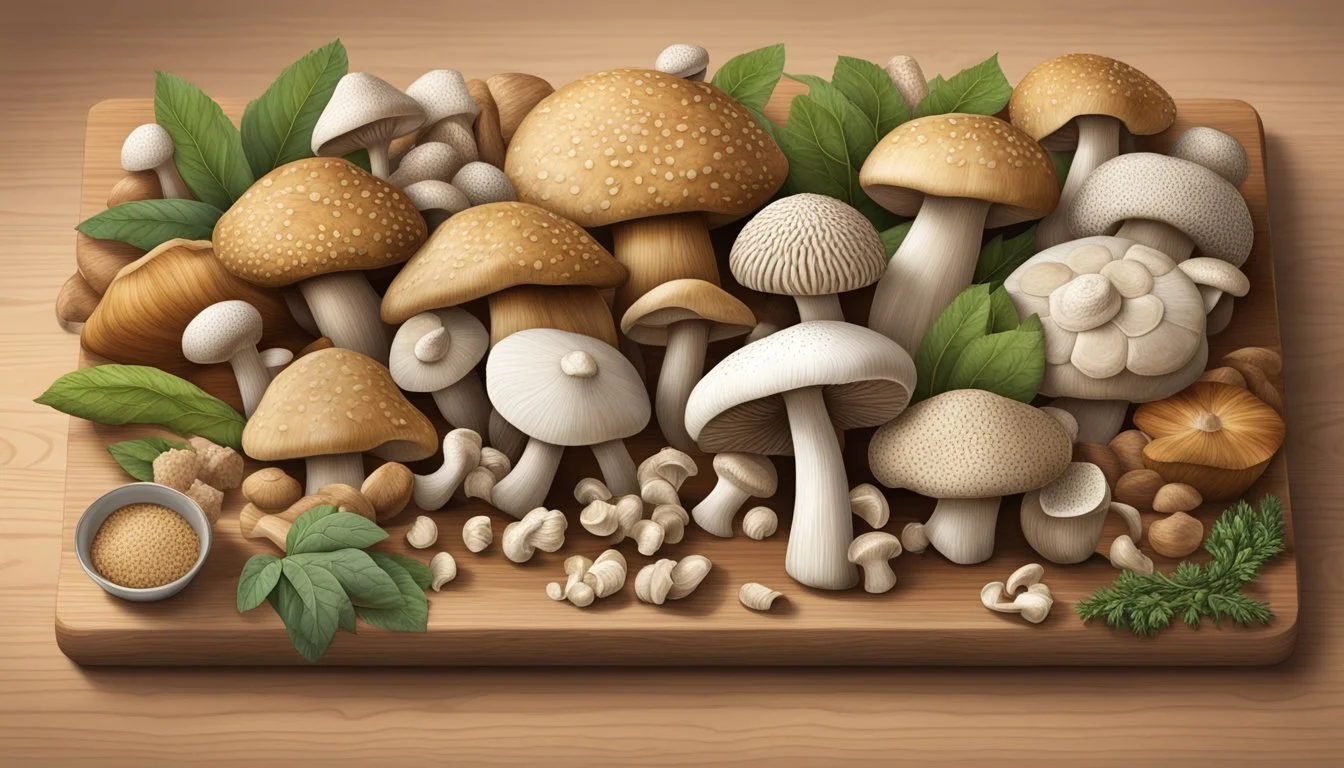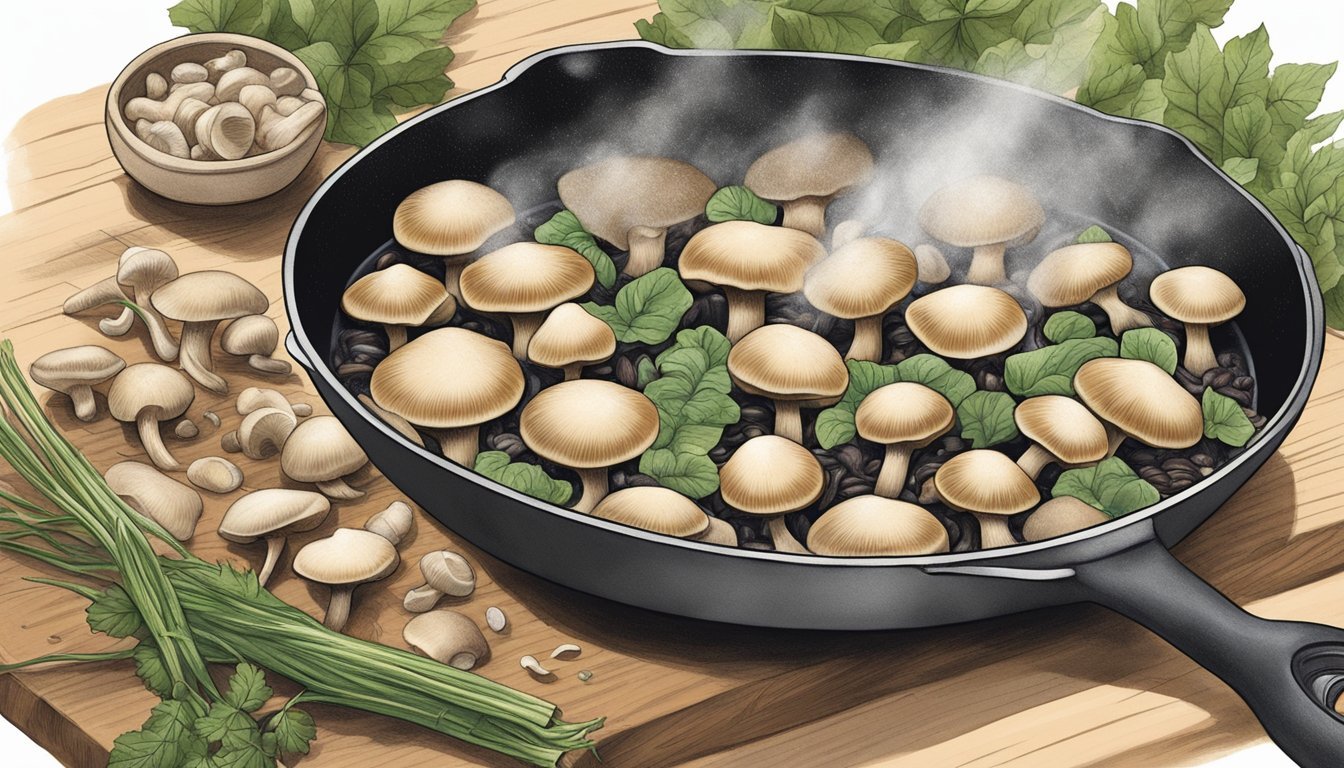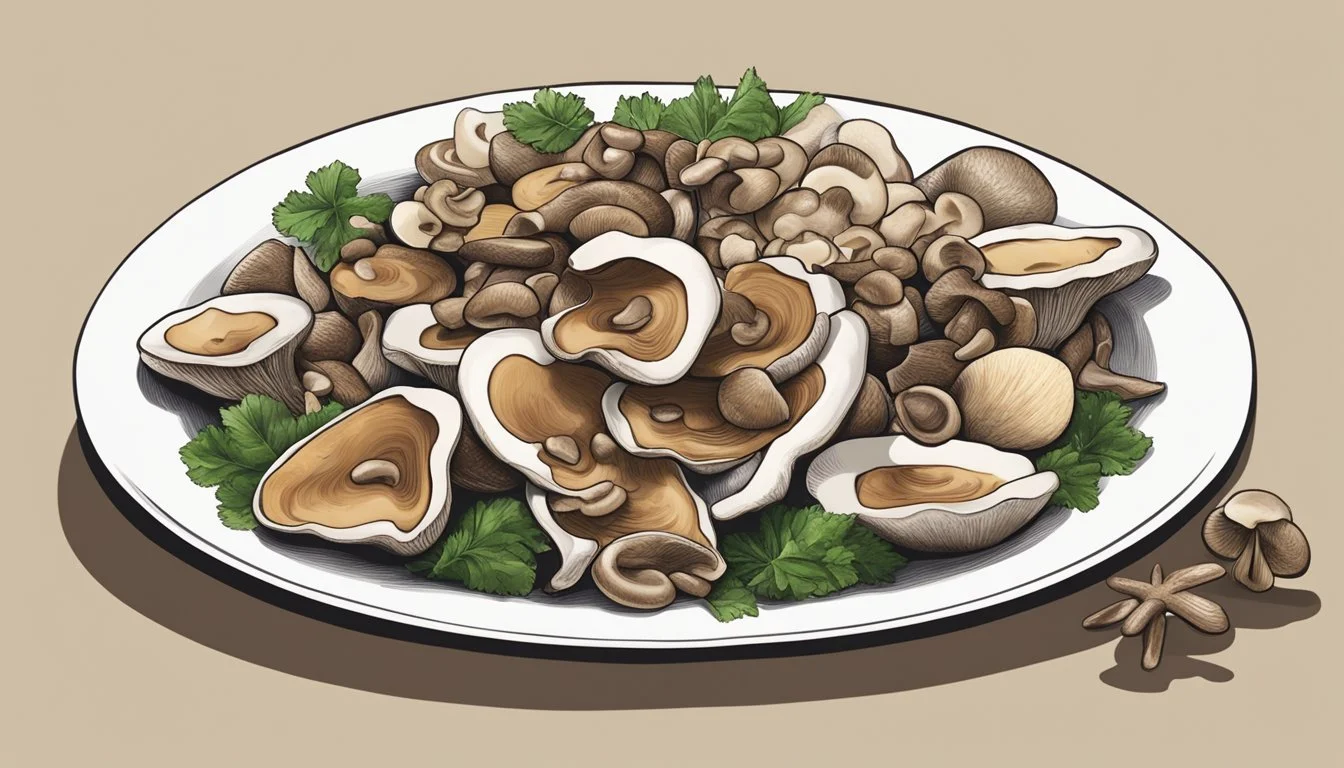Beech Mushrooms Substitutes
Top Alternatives for Cooking
Beech mushrooms, known for their nutty flavor and crunchy texture, are a delight in the culinary world. Yet, one might wonder what substitutes can be used if beech mushrooms are unavailable. Oyster mushrooms, cremini mushrooms, and white button mushrooms are excellent substitutes and can recreate a similar experience in various dishes.
These substitutes bring their own unique characteristics that enrich the flavor profile of any meal. Oyster mushrooms, for instance, mirror the delicate texture of beech mushrooms, while cremini mushrooms offer a rich earthiness. White button mushrooms, common and versatile, can serve as a reliable alternative in soups, stir-fries, and more.
Understanding the versatility of these substitutes allows for flexibility in cooking without compromising on taste. Substitutes like oyster and cremini mushrooms not only replicate the desired texture but also maintain the nutty and savory flavors appreciated in beech mushrooms. This adaptability ensures that even without the original ingredient, the essence of the dish remains intact.
Beech Mushroom Characteristics
Beech mushrooms are known for their distinctive flavor, texture, and nutritional benefits. They come in different types and are cultivated for their unique culinary qualities.
Flavor and Texture
Beech mushrooms have a mild, nutty flavor with subtle hints of sweetness.
The texture is firm and slightly crunchy, which adds a pleasant bite to dishes.
White beech mushrooms, also called white clamshell mushrooms, and brown beech mushrooms offer similar tastes, with the latter having a slightly more intense earthiness.
Their ability to retain texture even when cooked makes them ideal for stir-fries, soups, and sautés.
Cultivation and Types
Beech mushrooms, scientifically known as Hypsizygus tessellatus, are native to East Asia.
They grow primarily on hardwood trees, particularly beech trees.
Cultivation of beech mushrooms has spread to North America, Europe, and Australia.
In markets, you can find two main types: white and brown beech mushrooms.
These varieties are cultivated in controlled environments to ensure consistent quality and availability year-round.
Nutritional Value
Beech mushrooms are a nutritious addition to meals.
They are low in calories but rich in vitamins and minerals, including vitamin D, potassium, and B vitamins.
The fiber content in beech mushrooms aids in digestion and promotes gut health.
They also contain antioxidants and bioactive compounds that support overall health.
Incorporating beech mushrooms into a balanced diet can contribute to meeting daily nutritional needs while enhancing the flavor and texture of dishes.
Choosing a Substitute
Selecting the right substitute for beech mushrooms requires attention to flavor matching and texture to ensure the dish remains enjoyable.
What to Consider
Choosing a suitable replacement involves evaluating the intended use of the beech mushrooms in the recipe. For dishes that rely heavily on the mild flavor and delicate texture of beech mushrooms, it’s crucial to find a substitute that mimics these characteristics closely.
Texture is particularly important in dishes like stir-fries and soups where the mushrooms are expected to provide a firm yet tender bite. Substitutes like zucchini or carrots, which have a slightly crisp texture, can work well.
Protein and dietary fiber are also significant. Beech mushrooms contribute to the overall nutritional profile of a dish, so selecting a substitute that is rich in these nutrients can be beneficial. Consider options like lentils or beans if nutritional content is a priority.
Flavor Matching
Flavor matching is essential to maintain the taste profile of your dish. Beech mushrooms have a mild, earthy flavor, making it important to choose substitutes that won't overpower the other ingredients.
Vegetables such as zucchini or bell peppers can serve as good replacements due to their subtle flavors. Zucchini, for example, has a neutral taste and can absorb the surrounding flavors, making it an adaptable substitute in various recipes.
Conversely, for a richer, more umami flavor, using broths like vegetable or chicken broth can enhance the savoriness when mushrooms are omitted. Additionally, ingredients like leeks offer a mild oniony flavor that can complement many dishes without overwhelming the taste buds.
By considering both the texture and flavor profiles, you can select the most appropriate substitute for beech mushrooms while keeping the dish balanced and delicious.
Common Mushroom Substitutes
When looking to substitute beech mushrooms in your recipes, consider these common varieties which each offer unique flavors and textures that can effectively replace beech mushrooms. The following sections detail each substitute, highlighting their characteristics and best uses.
Button Mushrooms
White button mushrooms are a versatile alternative for beech mushrooms. These mushrooms have a mild taste and firm texture, making them suitable for a variety of dishes.
They can be sautéed, grilled, or used raw in salads. Their neutral flavor allows them to absorb other ingredients' flavors well, making them a reliable substitute.
Oyster Mushrooms
Oyster mushrooms are another excellent substitute. Known for their delicate flavor and velvety texture, they add a subtle richness to dishes.
These mushrooms work particularly well in stir-fries, soups, and even as a meat substitute in vegetarian dishes. They are also high in nutrients, providing a healthy option.
Shiitake Mushrooms
Shiitake mushrooms offer a robust and earthy flavor that can add depth to recipes originally calling for beech mushrooms. Their meaty texture holds up well in stews and sautés.
They are an ideal choice in Asian cuisine and provide a strong umami taste that can enhance any dish. Fresh or dried varieties can be used, though dried shiitakes need to be rehydrated before use.
Portobello Mushrooms
Portobello mushrooms are larger and have a meatier texture compared to beech mushrooms. They bring a rich, earthy flavor that works well in grilled dishes, sandwiches, and stuffed recipes.
Their sizeable caps make them a perfect substitute for meat in burgers or as a meal on their own. Slice them thinly to mimic the shape and texture of beech mushrooms in your recipes.
Enoki Mushrooms
Enoki mushrooms are thin and have a crunchy texture, making them a unique substitute. They have a mild, slightly fruity taste and can be eaten raw or cooked.
These mushrooms add an interesting texture to salads, soups, and hot pots. When substituting, take note of their distinct shape and texture differences from beech mushrooms.
Cremini Mushrooms
Cremini mushrooms, also known as baby bellas, are another suitable substitute. They possess a deeper flavor than white button mushrooms and slightly firmer texture.
Their brown color and robust taste make them a great addition to pasta dishes, risottos, and casseroles. Cremini mushrooms can be used interchangeably with button mushrooms if a stronger flavor is desired.
Maitake Mushrooms
Maitake mushrooms, also known as hen-of-the-woods, have a rich, aromatic flavor and a slightly crunchy texture. They can add complexity to dishes, making them an excellent substitute for beech mushrooms.
These mushrooms work well in soups, sautés, and baked dishes. Their frilly edges caramelize nicely when cooked, adding a depth of flavor to various culinary creations.
Non-Mushroom Alternatives
For those who need a non-mushroom alternative, there are many options that provide unique flavors and textures. This section will focus on vegan and vegetarian substitutes, protein-rich foods, and those that work well in a variety of dishes.
Tempeh and Tofu
Tempeh and tofu are excellent choices for those looking to replicate the meaty texture of beech mushrooms. Tempeh, made from fermented soybeans, has a hearty and nutty flavor. It offers a firm texture and can be sliced or crumbled into dishes.
Tofu, particularly firm or extra-firm varieties, soaks up flavors from marinades and sauces, similar to mushrooms. It has a mild taste and a versatile texture that works well in stir-fries, soups, and stews. Tofu is a great source of protein, making it popular among vegans and vegetarians.
Zucchini and Eggplant
Zucchini and eggplant are fantastic vegetable substitutes. Zucchini has a spongy texture that absorbs flavors well, making it ideal for stir-fries and casseroles. It doesn't overpower dishes, making it a good substitute in recipes where mushrooms would be too subtle.
Eggplant has a meatier texture and can add bulk to dishes. When cooked, it provides a rich and slightly smoky flavor. It works well in grilled, roasted, or sautéed preparations. Both zucchini and eggplant are versatile and can be used to replace mushrooms in a variety of dishes.
Sun-Dried Tomatoes
Sun-dried tomatoes bring a chewy texture and a burst of umami flavor. They're an excellent choice for adding depth to dishes that rely on mushrooms for their savory notes. Sun-dried tomatoes can be used in soups, stews, salads, and pasta dishes.
Their concentrated flavor pairs well with garlic, herbs, and olive oil. Rehydrating them in water or broth before use can make them more pliable. These tomatoes offer a different yet complementary taste profile, making them a flavorful alternative to mushrooms.
Russet Potatoes
Russet potatoes provide a starchy alternative to mushrooms. They have a robust texture that can hold up in hearty dishes like soups, stews, and casseroles. Potatoes can absorb flavors from the other ingredients they are cooked with, similar to mushrooms.
When diced or sliced, russet potatoes add bulk and substance to meals. They are also a great source of carbohydrates, making them a filling substitute. For a crispy texture, they can be roasted or sautéed until golden brown.
Chickpeas and Lentils
Chickpeas and lentils are protein-rich legumes that can act as a nutritious and hearty substitute for mushrooms. Chickpeas, when cooked, have a slightly nutty flavor and firm texture. They can be used in salads, stews, and even roasted as a crunchy snack.
Lentils come in various types, such as green, brown, and red, each offering a different texture and taste. They are excellent in soups, casseroles, and curries. Both chickpeas and lentils add protein and substance to dishes, making them suitable for vegetarian and vegan diets.
Jackfruit
Jackfruit is a unique alternative, especially for those seeking a meat substitute. Young jackfruit has a fibrous texture that can mimic shredded meat, making it ideal for tacos, sandwiches, and stir-fries. It has a neutral flavor, allowing it to take on the seasoning of the dish it's cooked in.
When cooked, jackfruit becomes tender and absorbs marinades and sauces well. It's commonly used in vegan and vegetarian cooking for its texture and versatility. Jackfruit can be a surprising yet effective replacement for beech mushrooms in many recipes.
Freezing and Storage Tips
To maintain the quality of beech mushrooms, proper freezing and storage are essential. This section provides practical methods to preserve freshness and avoid spoilage, including the use of paper bags and refrigerators.
Preserving Freshness
Beech mushrooms can last longer when stored correctly. Begin by gently wiping away any dirt with a damp paper towel. Avoid washing them as they can absorb excess water. Place the cleaned mushrooms in a paper bag, as this material allows for airflow and prevents moisture buildup. Fold the top of the bag over and store it in the refrigerator's crisper drawer where the temperature is stable.
For long-term storage, freezing is a good option. Blanch the mushrooms briefly by submerging them in boiling water for 1-3 minutes, depending on their size. Cool them promptly in ice water. Drain thoroughly, spread them on a baking sheet, and freeze until solid. Once frozen, transfer them to freezer-safe containers or bags, leaving a small amount of space for expansion.
Avoiding Spoilage
Preventing spoilage is crucial to maintain the quality of beech mushrooms. Using a refrigerator helps keep them at a consistent, cool temperature. It is important to avoid using plastic bags, as they can trap moisture and cause the mushrooms to become slimy. Instead, paper bags or wax paper work well for preventing excess moisture.
When freezing, ensuring that as much air as possible is removed from the containers helps prevent freezer burn. Always label the containers with dates to manage rotation and use the older items first. By following these steps, beech mushrooms can be kept fresh and ready for use in various recipes.
Culinary Uses of Substitutes
Substitutes for beech mushrooms offer versatility in various culinary applications, enhancing flavors and textures in everything from soups to salads. They play a vital role in vegan and vegetarian dishes, providing nutrient-rich options.
In Soups and Stews
In soups and stews, substitutes such as zucchini and cauliflower are excellent choices. Zucchini absorbs and retains flavors well, adding volume without overshadowing the dish. Cauliflower offers a similar texture to mushrooms when cooked, making it ideal for hearty stews and broths. For a protein boost, lentils and chickpeas can replace mushrooms, enhancing the nutritional content while maintaining a satisfying bite.
Stir-Fries and Sautéing
When used in stir-fries and sautéed dishes, tofu is a standout substitute. With its mild flavor and ability to soak up sauces, tofu fits perfectly into Asian cuisine, pairing well with soy sauce and other seasonings. Green beans add a crunchy texture and work excellently in stir-fries or sautéed vegetables. For a unique twist, okra can lend its distinct texture to these dishes, creating an interesting flavor profile.
Pasta and Risottos
In pasta and risotto recipes, eggplant and summer squash serve as robust substitutes for beech mushrooms. Eggplant provides a meaty texture that complements the creamy nature of risottos, while summer squash blends seamlessly into mushroom pasta dishes, creating a lighter version. Adding beans like cannellini or navy beans can enrich the dish with protein and fiber, rounding out the meal.
Salads and Garnishes
Roasted bell peppers and artichoke hearts make excellent mushroom substitutes in salads and garnishes. They add depth and a burst of flavor, enhancing the overall presentation. Marinated tofu can also bring a rich, satisfying taste to green salads and serve as a protein-rich garnish. Thinly sliced radishes or carrots can replace mushrooms for a crisp texture, brightening up the dish.
Vegan and Vegetarian Dishes
For vegan and vegetarian meals, jackfruit and tempeh stand out as flexible substitutes. Jackfruit mimics the texture of mushrooms with its fibrous consistency, making it perfect for vegan stews or stir-fried dishes. Tempeh, with its nutty flavor, can be marinated and used in place of mushrooms in a variety of recipes, offering a substantial and nutritious alternative. Beans and legumes also provide versatile options, integrating well into many vegetarian recipes.
Enhancing Flavors and Textures
Enhancing the flavors and textures of dishes that use beech mushroom substitutes can be achieved through careful selection of spices, herbs, oils, and seasoning. These components can complement and elevate the taste and mouthfeel of the meal.
Spices and Herbs
Utilizing spices and herbs can significantly boost the flavor profile of dishes containing beech mushroom substitutes. Garlic is a potent choice, adding depth and savory notes.
Cilantro and parsley provide a fresh, vibrant taste. Rosemary and thyme can also be excellent options due to their aromatic properties.
Dried herbs and spice blends, such as Italian seasoning or herbes de Provence, can enhance the complexity of the dish.
When using spices, it’s crucial to balance strong flavors to avoid overwhelming the subtler tastes of the primary ingredients.
Oils and Fats
The choice of oils and fats plays a significant role in both flavor and texture. Olive oil is commonly used for its smooth, fruity taste. Drizzling extra virgin olive oil over a dish can add a luxurious touch.
Butter offers a rich, creamy texture that enhances the mouthfeel of the dish.
Sesame oil provides a nutty flavor, making it suitable for Asian-inspired recipes. For a lighter option, use vegetable oil which doesn’t alter the dish’s inherent flavors much.
Including different fats in cooking can prevent dryness and add a pleasing richness.
Using Salt and Pepper
Salt and pepper are essential in bringing out and enhancing the natural flavors of ingredients. Proper use of salt can elevate a dish by balancing sweetness, bitterness, and acidity.
Sea salt or kosher salt can be preferred for their pure flavor.
Pepper, particularly freshly ground black pepper, can add a subtle heat and complexity. For an extra twist, consider using cracked peppercorns for varied texture and intensity.
Taste constantly during cooking to ensure that the seasoning levels are just right. Balancing these basics is key to a well-seasoned dish.
Health Benefits of Alternatives
Various alternatives to beech mushrooms, such as chickpeas, lentils, and tofu, offer a range of health benefits. These substitutes provide essential nutrients and can fit into different dietary needs.
Nutritional Advantages
Chickpeas and lentils, both legumes, are rich in protein and fiber. Chickpeas provide about 15 grams of protein and 12 grams of dietary fiber per cooked cup, aiding in muscle maintenance and digestive health. They also supply important vitamins and minerals like iron, magnesium, and vitamin B6.
Tofu is another excellent alternative. It offers about 20 grams of protein per cup and is low in fat. It is also a good source of calcium, iron, and essential amino acids. Additionally, tofu contains antioxidants that may help in reducing oxidative stress in the body.
Bamboo shoots and artichoke hearts contain dietary fiber as well. Bamboo shoots are low in fat and calories but high in fiber and potassium. Artichoke hearts provide vitamins such as vitamin C, K, and several B vitamins, as well as minerals like magnesium and phosphorus.
Dietary Considerations
For vegetarians and those on plant-based diets, these mushroom alternatives offer substantial protein sources that support muscle and overall health. Tofu and tempeh are particularly valuable due to their versatility and nutrient profiles.
Bamboo shoots and artichoke hearts can cater to low-calorie and low-fat dietary needs. They are suitable for various dietary plans focused on reducing fat intake while maintaining nutrient density. Lentils and chickpeas are also beneficial for those avoiding animal products, as they deliver essential nutrients without the need for meat.
In integrating these substitutes, individuals can maintain a balanced diet rich in fiber, vitamins, and minerals. They offer a way to diversify meals while ensuring nutritional adequacy.









